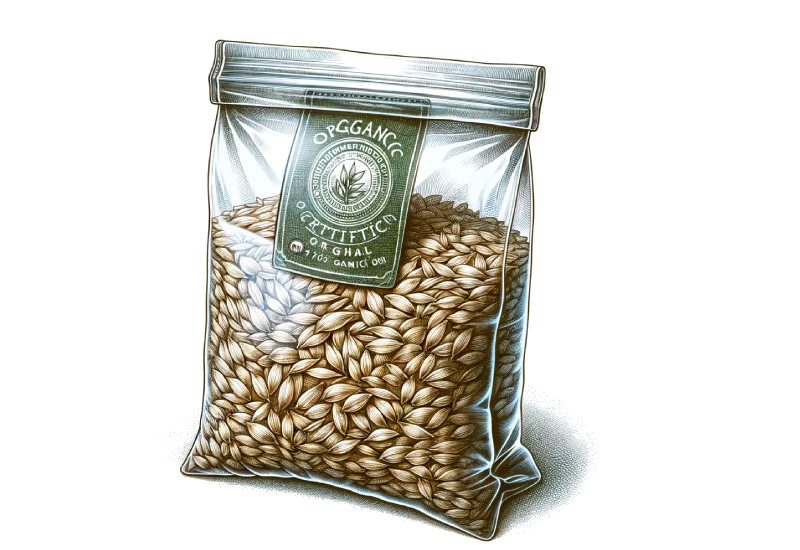Morels, with their honeycombed silhouette and characteristic brown hue, are among the most sought-after mushrooms in the world. Prized by gourmets, they stand out for a deep flavor, both woody and slightly nutty, which enhances the most refined dishes.

Their unique texture, both firm and delicate, adds an incomparable dimension in cooking. The rarity of the morel, its short season, and its cultivation difficulty make it a luxury delicacy, arousing the desire of mushroom enthusiasts and starred chefs. This mysterious mushroom continues to fascinate both for its taste and the challenges it poses to those who try to cultivate it.
🍄 Table of Contents 🍄
Our quality commitment:
We produce our mycelium under laboratory conditions, thus guaranteeing varietal purity and optimal quality.

Certified organic with the BE-BIO-01 label, our grain spawns comply with the strict standards of organic farming.
1. Introduction to Morel Cultivation
Historical Context: The First Steps Toward Morel Cultivation
Morel cultivation has long been considered the Grail of mycologists due to numerous unsuccessful attempts to master their complex life cycle.
It was not until the 1980s that American researchers succeeded in cultivating morels in controlled environments, marking a turning point in the history of this mushroom. In 1982, a team of scientists from Ohio State University succeeded for the first time in producing morels in the laboratory, paving the way for significant advances in the field.
Subsequently, Chinese researchers made remarkable progress, filing patents for improved cultivation methods that enabled more systematic production. These innovations helped transform morel cultivation from an unpredictable process into an increasingly mastered science, although challenges still remain.

Challenges of Morille Cultivation
Morille cultivation remains a major challenge due to their specific and capricious requirements. This mushroom needs a controlled environment, with precise temperature and humidity, to thrive.
Morilles develop in rich, often calcareous soils, and require a complex interaction with soil microorganisms to fruit. They need a delicate balance of nutrients, moisture, and light, which makes outdoor cultivation subject to climatic hazards and difficult to reproduce on a large scale.
Moreover, the morille fruiting process is stimulated by specific environmental factors, such as temperature fluctuations or stress events like drought followed by rain. These requirements make morille cultivation a delicate art combining science, observation, and constant adjustment of growth conditions.
Modern Methods of Morille Cultivation
Modern morille cultivation techniques differ from traditional approaches by a better understanding of pre-fructification conditions and the use of specially formulated substrates.
Today, cultivation in controlled environments allows reproducing the natural conditions necessary for mycelium development, making crops more predictable. Nutrient-enriched substrates, designed to mimic the natural soils where morilles grow, are used to promote healthy mycelium growth.
Optimizing pre-fructification conditions, such as precise adjustment of temperature and humidity, is crucial to encourage morilles to fruit. Modern methods also include regulating factors like soil pH and managing microbial interactions, which play a key role in the morille life cycle.

Ecological Impact and Benefits of Home Cultivation
Growing morilles at home has many benefits, both in terms of taste and ecology. By cultivating these rare mushrooms yourself, you reduce the pressure on natural morille populations, which are often victims of overharvesting. This practice helps preserve biodiversity and supports the maintenance of healthy forest ecosystems.
Moreover, home cultivation offers complete control over growth conditions, allowing to avoid the use of pesticides or chemicals that can harm the environment. Morilles grown at home are thus more sustainable and environmentally friendly, while providing the personal satisfaction of producing an exceptional mushroom. Furthermore, domestic cultivation of morilles allows mushroom enthusiasts to enjoy fresh morilles throughout the year, which is rarely possible with wild harvesting.
By combining passion, patience, and modern techniques, home morel cultivation opens a world of flavors and discoveries to amateur mycologists and gourmets.
2. The Choice of Mycélium sur grains and Substrate
The success of morel cultivation largely depends on the choice of mycélium sur grains and the preparation of a suitable substrate.
Saprophytic morels, which feed on decomposing organic matter, are the most suitable for home cultivation, unlike symbiotic varieties that require a mycorrhizal relationship with specific host trees.
Which variety of morels?
Morchella importuna : Known for its conical black morels, Morchella importuna is a species well suited for home cultivation, especially in well-drained soils rich in organic matter.
It ideally develops in substrates enriched with composted wood and appreciates moderate shade exposure. This variety requires special attention to maintain proper humidity and temperature conditions, but it rewards efforts with generous harvests of morels with a pronounced flavor.
Some morels, such as symbiotic varieties like Morchella esculenta, depend on a mycorrhizal relationship with specific host trees such as ash, elm, or apple trees.
These species are not suited for open soil cultivation as they require a complex interaction with their partner trees to develop. For this reason, it is better to focus on saprophytic varieties that can be self-fed from substrates rich in organic matter.
Our quality commitment:
We produce our mycelium under laboratory conditions, thus guaranteeing varietal purity and optimal quality.

Certified organic with the BE-BIO-01 label, our grain spawns comply with the strict standards of organic farming.
3. Optimal Conditions for Morel Cultivation
Morel cultivation relies on creating an environment that mimics their natural habitat as closely as possible. Morels are sensitive to variations in temperature, humidity, and light, and respecting these specific conditions is essential to promote their growth and fruiting.
Soil Qualities:
- Optimal pH: For morel cultivation, the soil should have a pH between 7 and 8. If necessary, the pH can be adjusted by adding calcium carbonate (CaCO₃), such as chalk. A soil analysis is recommended to determine the exact amount of amendment to add to correct acidity.
- Fungal Properties: Check that the substrate does not contain inhibitory substances such as tannins which can come from certain tree species (for example, conifers or walnut trees) or plants (such as sage or laurel), as well as wood chips or uncomposted leaves.
- Water Quality: Favor soft, uncontaminated water for irrigation, ideally from natural sources like rain or streams, to avoid adding unwanted minerals.
- Absence of Chemicals: Avoid chemical treatments, especially fungicides such as glyphosate, which can disrupt the network of symbiotic microorganisms necessary for morel growth.
🌡️ Temperature:
Temperature management is one of the most critical aspects of morel cultivation. Cultivation should begin when air temperatures are between 10°C and 20°C, typical conditions of spring or autumn. During the grain spawn incubation phase, it is crucial to maintain a stable temperature around 20°C.
Subsequently, a gradual drop in temperatures, ideally down to 5°C, is necessary to stimulate the formation of sclerotia. These compact grain spawn structures serve as nutrient reserves and are essential to trigger morel fruiting. This temperature drop mimics natural late winter or early spring conditions, marking the start of the morel life cycle.
💧 Humidity:
Morels require a high humidity level to develop properly. The soil must be kept constantly moist, but not excessively, as water saturation could lead to grain spawn rot.
Fine irrigation, such as that provided by a misting system or drip irrigation, is recommended. This type of watering helps maintain constant and controlled humidity without damaging the fragile grain spawn. It is important to avoid watering with strong jets of water, which could disturb the soil and destroy delicate developing structures.
☁️ Light:
Morels are mushrooms that prefer diffuse light, similar to that found in undergrowth or shaded forests. They do not like direct sunlight, which can dry out the substrate and compromise fruiting.
To control light exposure, using shade nets, tunnels, or partially covered greenhouses is ideal. These setups recreate an environment where the light is filtered, while providing protection against extreme weather conditions, such as wind or heavy rain, which could affect morel growth.
Summary of Optimal Conditions:
-
 Température : Débuter à 10-20°C, puis diminution progressive à 5°C.
Température : Débuter à 10-20°C, puis diminution progressive à 5°C. -
 Humidité : Maintenir une humidité constante avec une irrigation fine.
Humidité : Maintenir une humidité constante avec une irrigation fine. -
 Lumière : Utiliser une lumière diffuse en simulant l’ombre des sous-bois.
Lumière : Utiliser une lumière diffuse en simulant l’ombre des sous-bois.
By combining these parameters with a well-prepared substrate and quality mycelium, you can create a microclimate conducive to morel cultivation, thus maximizing your chances of successfully growing this delicate and coveted mushroom.
At the substrate level : Soil preparation is crucial to promote morel growth and optimize fruiting.
-
pH : The substrate should have a slightly alkaline pH, ideally between 7 and 8, measurable with pH test strips. It may be necessary to amend with calcium carbonate, blanc de Meudon, or limestone lime. Avoid lime rich in magnesium, which is generally unsuitable for mushroom cultivation.
-
Organic matter : As a secondary decomposer, morel mycelium will appreciate soil rich in already pre-decomposed organic matter. If you have wood chips, ideally let them compost for one year, then incorporate them into the top 5 centimeters of soil in spring or summer. Manure should also be aged 2 to 3 years before being mixed into the soil for morels. A good substrate mimics the natural forest soil of morels, thus promoting their development.
-
Moisture and Drainage : The soil must be kept moist, but it is essential to ensure good drainage to avoid water stagnation that could harm morel development. Prior soil preparation, such as digging to make the soil cloddy and aerated, is necessary to create a favorable environment for the mycelium. It is also recommended to install a drip irrigation system to maintain constant moisture without saturating the substrate.
Importance of Organic Matter (OM)
Morels, saprophytic mushrooms, depend on highly decomposed organic matter for their nutrition. Organic amendments must be well incorporated into the topsoil layer (10 to 15 cm deep) and preferably applied before or during summer, taking advantage of the heat to accelerate decomposition and neutralize potential contaminants.
Did you know? Soil organic matter plays a key role in the flavor of morels. Cultivated morels are therefore not necessarily less tasty than wild morels; this mainly depends on the quality and quantity of organic matter in the soil.
Recommended Organic Matter Inputs:
- Composted Hardwood Wood Chips : Enrich the soil with well-balanced organic matter.
- Composted Manures : Provide essential nutrients and improve soil structure.
- Methanization Digestate : Resulting from the anaerobic decomposition of organic matter, it constitutes a rich amendment.
- Vermicompost (Lombricompost) : This compost, enriched by earthworm activity, supports soil health and stimulates beneficial microorganisms.
To avoid soil saturation, it is advisable to limit inputs to about 1 to 2 kg per square meter per year. Organic matter houses nitrifying bacteria, such as Pseudomonas putida, which plays a symbiotic role with the morel mycelium, helping to enrich it with nutrients at the time of sclerotia formation.
Soil Preparation and Arrangement
Soil work is a key step to establish a good growing bed for morels, especially if the plot is newly dedicated to this crop. Well-prepared soil improves growth conditions.
- Weed Reduction : If the plot is still virgin of any crop, perform several false sowings to reduce weeds before starting cultivation.
- Amendment and pH Regulation : Amendments to adjust pH or control harmful populations must be incorporated just after plowing, before the final soil preparation.
- Soil Structure : The soil must be loose with medium-sized clods (about the size of an egg) and formed into raised beds 0.80 m to 1.50 m wide to facilitate drainage.
Irrigation and Humidity Management
Humidity is a crucial factor for morel cultivation, and the irrigation system must be adapted to the soil characteristics to maintain an optimal environment throughout the different stages.
Key Instructions:
- Pre-Sowing Saturation : The soil must be well saturated with water before sowing the mycelium.
- Humidity Maintenance : Keep the substrate constantly moist to promote the growth of the mycelium.
- Irrigation Precautions : Avoid watering the grain spawn directly during propagation and refrain from watering young morels measuring less than 3 to 4 cm to prevent damage.
4. Culture Installation
Grain Spawn Reception and Storage
To guarantee the quality of the grain spawn, it is important to follow certain steps during its reception and storage:
- Grain spawn reception: The grain spawn is generally delivered between mid-October and mid-November.
- Immediate use: If climatic conditions are favorable, it is preferable to use the grain spawn upon receipt to maximize its chances of success (see the section "Sowing management").
- Grain spawn storage: If immediate use is not possible, open the boxes and place each bag on a shelf in a cold room maintained at a temperature of 2°C. If you do not have a shelf, the boxes can be stacked ensuring that the bags do not stick to each other.
- Storage material: Keep the delivery boxes as well as the bubble wrap to protect the grain spawn bags outside of cultivation periods.
Soil Preparation and Inoculation
The inoculation phase is crucial for successful morel cultivation. At La Mycosphère, two main techniques are recommended for seeding:
-
Broadcast sowing: Spread between 200 and 300 g of grain spawn per square meter, then cover it with 2 to 4 cm of soil. This method is simple and ensures uniform soil coverage.
-
Patch sowing: Bury 100 to 200 g of grain spawn in holes 10 cm deep, spaced 50 cm apart. Although more laborious, this technique protects the grain spawn from contaminants and improves its growth by directing the filaments towards the surface.
Before inoculation, it is essential that the soil is well moist, either after natural rain or thanks to a fine watering. To ensure natural shading and maintain good hygrometry, you can lightly sow cereals such as wheat or rye over the grain spawn. This also helps protect the grain spawn from the wind.
Temperatures for Morel Sowing
To start the sowing, the temperature under the climatic shelter must not exceed 20°C and must remain below this value sustainably. This temperature should be measured 10 cm above the soil, at the peak of the day.
5. Maintenance and Monitoring of the Culture
To ensure optimal mycelium growth, regular maintenance is essential. Here are the steps to follow to ensure the success of your morel cultivation:
Mycelium Monitoring
After soil inoculation, it is crucial to carefully monitor the appearance of signs of mycelium growth. Look for the « déflagrations », those concentric circles that appear on the soil surface, signaling the expansion of the grain spawn. This process can vary in duration, generally from 1 to 3 weeks, depending on environmental conditions such as temperature and humidity.

Feeding:
The morel will first feed on its so-called "endogenous" food present in the soil. Quickly, the morel mycelium will need to be fed with so-called "exogenous" food, placed directly on the soil. This hungry fungus requires sugar inputs (starches, cellulose, and simple sugars). We recommend our nutrient bags, to be placed with an opening towards the soil.
Another more traditional technique involves placing cooked apples, cut in half, with the cut side on the mycelium deflagration. However, this method carries a higher risk of contamination with unwanted molds.
The morel mycelium will thus move from a rich environment (its inoculation point) through a nutrient-poor environment (the soil) to again a sugar-rich environment (the exogenous food). This alternation of environmental richness will allow the mycelium to properly develop its sclerotia, which will then produce beautiful morels.
These food bags will be left in place for a few weeks, untouched, except in cases of contamination by molds or insects. By carefully observing the bags, you should see the grain spawn colonize the grains in the days following their placement. Around March-April, when temperatures begin to rise, about 2 to 3 weeks before fruiting, these bags will be removed.
Our quality commitment:
Our nutrient bags are designed to provide the necessary nutrients for morel cultivation under optimal conditions.

Certified organic with the BEBIO01 label, our nutrient bags comply with the strict standards of organic farming.
Watering
Maintaining a constant humidity level is vital for mycelium growth. Ensure the soil remains moist but avoid excess water that could cause rot or stagnation, which are harmful to the crop. Using perforated pipes or a micro-drip system is recommended for gentle watering. Avoid watering young morels directly to not disturb their delicate development.
Protection against Parasites
Morel cultivation can be threatened by various parasites, including insects and molds. To minimize these risks, install a shade cloth and a protective tarp. These devices help create a controlled environment, reducing the risk of contamination.
For effective biological control against larvae, slugs, and other pests, you can use Bacillus thuringiensis (BT), a bacterium naturally present in the soil that specifically targets harmful insects without damaging the crop. Be sure to follow the manufacturer's instructions for proper use.
Management of Birds and Rodents
Birds and rodents can also pose a threat to morel crops by digging in the soil or unearthing young mushrooms. To deter them, you can use protective nets or natural repellents. Installing physical barriers around cultivation areas can also help protect your harvest.
6. Fruiting: Encouraging Morel Growth
7. Harvest and Post-Harvest
-
Harvest Period : Morels are mainly harvested in spring, generally between March and May in the northern hemisphere, although this can vary slightly depending on climate and altitude. In France, the season often starts in March and can extend until June in some mountainous regions.
-
Harvest Size: The recommended size to harvest morels is generally when they measure between 5 and 10 cm, although this can vary according to personal preferences and culinary uses. A 10 cm morel is already considered relatively large.
-
Harvest Method: Cutting the morel at the base with a clean knife is indeed recommended to preserve the mycelium and encourage future fruiting. This practice is crucial for the sustainability of harvesting sites.
-
Harvest after watering: It is true that morels absorb a lot of water and become fragile after rain. Moreover, they can deteriorate more quickly, which reduces their taste quality.

After harvesting:
-
Post-Harvest Preparation :
- Morels must be handled carefully after harvesting. They should be placed in baskets or cloth bags to allow air circulation, thus preventing condensation and premature spoilage.
- They should be cleaned quickly but gently. Avoid soaking them in water; a light brushing or a quick rinse is sufficient. Morels are porous and absorb a lot of liquid, which can alter their texture and taste.
-
Drying and Storage :
- Morels keep better dried, a traditional and effective method to extend their shelf life. Drying also concentrates their flavor. They can be air-dried or dried at low temperature in an oven or dehydrator.
- Once dried, morels should be stored in a dry, dark place, ideally in airtight jars.
8. Conclusion
Growing morels is an exciting challenge that, when well mastered, offers you the satisfaction of harvesting fresh, tasty, homemade mushrooms. With the right techniques and suitable tools, you can turn this adventure into a rewarding success.
Our quality commitment:
We produce our mycelium under laboratory conditions, thus guaranteeing varietal purity and optimal quality.

Certified organic with the BE-BIO-01 label, our grain spawns comply with the strict standards of organic farming.
⚠️ Precautions
Morels must be cooked. They are toxic when raw.
If it is your first time eating this species, it is best to start with a small amount to check for possible allergies, even after cooking.
Allow about 10 minutes of cooking in a pan or pot for proper cooking.
❓ Frequently Asked Questions
Is it normal for my grain spawn to be brown?
Morel grain spawn goes through different maturity stages, which give it white, orange, then brown colors.
Should I water my crop?
Being rather a winter crop, the soils are generally naturally moist. Two periods must be considered: before inoculation, the soil must be well moist for a good start of the grain spawn, and in spring, during soil warming, it is often necessary to add water to maintain soil moisture.
Does it regrow every year?
No. Since it is a saprophytic variety, it decomposes dead matter and does not form mycorrhizae with surrounding trees. After fruiting, the morel grain spawn is weakened. It is also quite sensitive to heat and dryness, so it generally does not survive the summer unless the environment remains cool and moist.
Is it possible to cultivate them indoors?
It is possible, and it has already been done in Denmark. However, since outdoor morel cultivation is already relatively complex and experimental, indoor cultivation is even more so. The difficulty lies less in the colonization of a substrate by the grain spawn than in the technical conditions necessary for its fruiting.
Do cultivated morels taste the same as wild morels?
Yes, morels cultivated outdoors can be just as tasty as those harvested in the woods. The taste depends on the quality of the soil and its richness in organic matter. Excessive watering or rain during fruiting can diminish the taste of morels. For better preservation and taste, do not harvest morels just after rain.
Is it compatible with other crops in the vegetable garden?
Yes. Morel grain spawn is mainly implanted from October to December, and harvested from February to May. Morel grain spawn feeds, among other things, on the dead roots of cultivated plants.
I have acidic soil, will it work?
No, morels need a basic soil. You will need to add lime or calcium carbonate to raise the pH above 7 before implanting the grain spawn.








